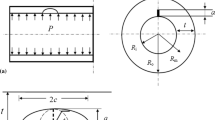Abstract
In this paper, two theoretical models, micro and macro model, are presented to investigate the effect of circumferential cracks on the structural characteristics of a pipe. In the micro model, the equivalent bending stiffness is obtained based on the energy method and fracture mechanics. Because of the high change of strain energy near the crack location, the variation is represented by reduction in the bending stiffness along the length of the pipe. The development of the macro model is based on a simplified procedure, i.e., the pipe is separated into two segments without any change in the cross section property. Two separated pieces are connected by a rotational massless spring of the infinitesimal length inserted at the crack location. Moreover, it is shown that in the macro model so smaller number of elements are required than the micro model to provide a sufficient accuracy. Finally, the experimental measurements are utilized to validate the proposed models. The deflections and frequencies obtained for several cases through the displacement and vibration method, using the proposed models agree reasonably well with the experimental measurement data.
Similar content being viewed by others
References
Bathe, K. J. (2013). Finite element procedures, Prentice Hall, New York, USA, pp. 149–192.
Behzad, M., Ghadami, A., Maghsoodi, A., and Michael, J. (2013). “Vibration based algorithm for crack detection in cantilever beam containing two different types of cracks.” Journal of Sound and Vibration, Vol. 332, No. 24, 6312–6320, DOI: 10.1016/j.jsv.2013.07.003.
Cook, R. D., Malkus, D. S., Plesha, M. E., and Witt, R. J. (1996). Concepts and applications of finite element analysis, John Wiley & Sons, Madison, USA, pp. 109–136.
Doebling, S. W., Farrar, C. R., Prime, M. B., and Shevitz, D. W. (1996). Damage identification and health monitoring of structural and mechanical systems from changes in their vibration characteristics: A Literature Review, Los Alamos national laboratory report LA13070-MS, New Mexico, USA, DOI: 10.2172/249299.
Hellier, C. (2001). Handbook of nondestructive damage evaluation, McGraw-Hill, New York, USA, pp. 3.1-3-53.
Lee, J. W., Kim, S. R., and Huh, Y. C. (2014). “Pipe crack identification based on the energy method and committee of neural networks.” International Journal of Steel Structures, Vol. 14, No. 2, 345–354, DOI: 10.1007/s13296-014-2014-0.
Maghsoodi, A., Ghadami, A., and Mirdamadi, H. (2013). “Multiplecrack damage detection in multi-step beams by a novel local flexibility-based damage index.” Journal of Sound and Vibration, Vol. 332, pp. 294–305, DOI: 10.1016/j.jsv.2012.09.002.
Mehrjoo, M., Khaji, N., and Ghafory-Ashtiany, M. (2014). “New Timoshenko-cracked beam element and crack detection in beam-like structures using genetic algorithm.” Inverse Problems in Science and Engineering, Vol. 22, No. 3, 359–382, DOI: 10.1080/17415977.2013.788170.
Murigendrappa, S. M., Maiti, S. K., and Srirangarajan, H. R. (2004). “Frequency-based experimental and theoretical identification of multiple cracks in straight pipes filled with fluid.” NDT & E International, Vol. 37, No. 6, 431–438, DOI: 10.1016/j.ndteint.2003.11.009.
Murigendrappa, S. M., Maiti, S. K., and Srirangarajan, H. R. (2004). “Experimental and theoretical study on crack detection in pipes filled with fluid.” Journal of Sound and Vibration, Vol. 270, pp. 1013–1032, DOI: 10.1016/S0022-460X(03)00198-6.
Naik, S. S. (2012). “Crack detection in pipes using static deflection measurements.” Journal of the Institution of Engineers, Vol. 93, No. 3, 209–215, DOI: 10.1007/s40032-012-0027-z.
Ostachowicz, W. M. and Krawczuk, M. (1991). “Analysis of the effect of cracks on the natural frequencies of a cantilever beam.” Journal of Sound and Vibration, Vol. 150, No. 2, 191–201, DOI: 10.1016/0022-460X(91)90615-Q.
Swamidas, A. S. J., Yang, X., and Seshadri, R. (2004). “Identification of cracking in beam structures using Timoshenko and Euler formulations.” Journal of Engineering Mechanics, Vol. 130, No. 11, 1297–1308, DOI: 10.1061/(ASCE)0733-9399(2004).30:11(1297).
Tada, H., Paris, P. C., and Irwin, G. R. (2000). The stress analysis of cracks handbook, ASME, New York, USA, pp. 39–78.
Yang, X. F., Swamidas, A. S. J., and Seshadri, R. (2001). “Crack identification in vibrating beams using the energy method, Independent nondestructive testing and evaluation.” Journal of sound and vibration, Vol. 244, No. 2, 339–357, DOI: 10.1006/jsvi.2000.3498.
Author information
Authors and Affiliations
Corresponding author
Rights and permissions
About this article
Cite this article
Banimahd, A. Development of Finite Element Models for Predicting the Mechanical Behavior of the Cracked Pipe. KSCE J Civ Eng 22, 5035–5045 (2018). https://doi.org/10.1007/s12205-017-1361-8
Received:
Revised:
Accepted:
Published:
Issue Date:
DOI: https://doi.org/10.1007/s12205-017-1361-8




